Renault Clio
The Renault Clio is a supermini car (B-segment), produced by French automobile manufacturer Renault. It was launched in 1990, and was in its fourth generation in 2012. The Clio has had substantial critical and commercial success, being consistently one of Europe's top-selling cars since its launch,[1] and it is largely credited with restoring Renault's reputation and stature after a difficult second half of the 1980s. The Clio is one of only two cars, the other being the Volkswagen Golf, to have been voted European Car of the Year twice, in 1991 and 2006.
| Renault Clio | |
|---|---|
 Renault Clio V | |
| Overview | |
| Manufacturer | Renault |
| Also called | Renault Lutecia (Japan) |
| Production | 1990–present |
| Body and chassis | |
| Class | Supermini (B) |
| Body style | 3-door hatchback (Clio I - III) 5-door hatchback (1990–present) 4-door sedan (Clio II) 5-door estate (Clio III & IV) |
| Layout | Front-engine, front-wheel-drive |
| Chronology | |
| Predecessor | Renault 5 |
The Clio is sold as the Renault Lutecia (ルノー ルーテシア, Runō Rūteshia)[2] in Japan because Honda retains the rights to the name Clio after establishing the Honda Clio sales channel in 1984. Lutecia is derived from the name of Lutetia, an ancient Roman city that was the predecessor of Paris. The Renault Lutecia was formerly available through Yanase Co., Ltd., but in 1999 Renault purchased a stake in Japanese automaker Nissan. Following Renault's takeover, distribution rights for the Lutecia were handed over to Nissan locations in 2000.
Clio I (1990)
| Clio I | |
|---|---|
.jpg) | |
| Overview | |
| Also called | Renault Lutecia (Japan) |
| Production | 1990–1998 (France) 1996–2001 (Colombia) |
| Assembly | |
| Body and chassis | |
| Body style | 3/5-door hatchback |
| Powertrain | |
| Engine | |
| Transmission | 4/5-speed manual 3-speed automatic 4-speed automatic |
| Dimensions | |
| Wheelbase | 2,472 mm (97.3 in) |
| Length | 3,709 mm (146.0 in) |
| Width | 1,616 mm (63.6 in) (1990–1996) 1,625 mm (64.0 in) (1996–1998) |
| Height | 1,360 mm (53.5 in) |
| Curb weight | 930 kg (2,050 lb) |
Renault had replaced its R5 supermini with a completely redesigned model (which had similar styling to the 1972 original) in 1984, but soon afterwards began working on an all-new supermini to take the company into the 1990s. It was eventually decided that the new car would feature a name designation, rather than the numeric model designations which Renault had traditionally used. Cars like the Fuego coupe (launched in 1980) had been an exception to this rule, and the last "numeric" Renault was the 19, launched in 1988, and by the end of 1996 the numeric model designations had completely disappeared from the Renault range.
The Clio was introduced at the Paris Motor Show in June 1990 and sales in France and the rest of the continent began then, although sales on the right-hand drive Britain did not begin until March 1991. The Clio was the replacement to the hugely successful Renault 5, although this car remained in production until 1996 at a factory in Slovenia, where some versions of the Clio were later built. The Clio's suspension and floorpan were largely the same as the R5, which was derived from the R9 saloon of 1981 and R11 hatchback of 1983 - not that of the original 1972 Renault 5, despite the later R5 visually resembling the original model.
The suspension uses half-width torsion bars (full-width on higher spec models) with trailing arms at the rear, and coil sprung MacPherson struts, attached to a thick pressed steel subframe at the front. The engine range available at launch included 1.2 L and 1.4 L E-type "Energy" petrol inline-four engines (first seen in the Renault 19) and 1.7 L and 1.9 L diesel engines, both based on the F-type unit. The petrol engines gradually had their carburettors replaced with electronic fuel injection systems by the end of 1992, in order to conform to ever stricter pollutant emission regulations brought in by the EEC.
.jpg)
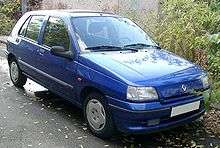
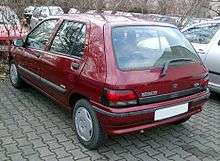
A minor trim facelift occurred after only a year of being on sale. A new "smooth" version of the Renault diamond badge (the previous "ribbed" badge was being phased out at the time) and a new front seat design were the only changes. The altered design did not constitute a new "phase". In March 1994 (at the Geneva Motor Show), the phase two model was launched, with small updates to the exterior and interior of the Clio.[4] Most noticeable was the change in the front grille from two metal ribs to a single colour-coded slat. The bump strips were made slightly larger and rounder and had the car's trim level badge incorporated into them. The badges on the tailgate strip were moved up onto the tailgate itself and the tailgate strip was given a carbon fibre look. The rear light clusters were given a slightly more rounded bubble shape, giving the Clio a more modern look. The clusters, however, are physically interchangeable with phase ones'.
In May 1996, with the arrival of the phase three facelifted Clio, the 1.2 L Energy engine was replaced by the 1,149 cc D7F MPi (multi point injection) DiET engine, first used in the Renault Twingo; for some time also, versions were available with the older 1239 cc "Cléon" unit from the original Twingo. The cylinder head design on the 1.4 L E-type was also slightly altered for the phase three models in a bid for better fuel economy. This resulted in the engines producing slightly less power than their earlier versions.
.jpg)
The phase three Clios have a slightly more noticeable update than the phase twos. The phase three has different, more rounded headlights, incorporating the turn signal in the unit with the headlight, and the bonnet curves more around the edges of the lights. The tailgate incorporates a third brake light and a new script "Clio" name badge, following the same typeface as contemporary Renaults. Some mechanical improvements were also made, as well as the introduction of side impact bars and airbags, which were now common features on mainstream cars across Europe.
Renault also released a hot hatch version of the Clio in 1991. It was aesthetically very similar, but with the addition of a 110 PS (81 kW) 1.8 L eight-valve engine, side skirts and disc brakes on all wheels. This, with multi-point fuel injection, was badged as the RSi.[4] From 1991 a lighter tuned version of this 1.8 litre engine (with single-point injection) joined the earlier 1.7 used in the very luxurious Baccara version which was sold in some continental European markets. In addition to this reasonably powerful engine, the Baccara has a luxurious interior with lots of leather and wood, as well as power windows, locks, etcetera. The Baccara was renamed "Initiale" in 1997, in line with other Renaults, differing from the Baccara mainly in the wheel design.
During 1991, a 1.8 L 16-valve engine producing 137 PS (101 kW) (also first seen in the Renault 19) capable of propelling the car to 209 km/h (130 mph) was introduced to the Clio engine range, known simply as the Clio 16S in France (S for "soupapes", the French word for valves), and Clio 16V in export markets. It was the successor to the Renault 5 GT Turbo, which was discontinued that year as the R5 range was pruned back.[5] As well as having a higher top speed than a regular Clio, the 16S sports wider plastic front wings, an offset bonnet vent, wider rear arches and uprated suspension and brakes, and colour-coded front mirrors and bumpers. The RSi side skirts were omitted, however. Inside, the 16V model has an extended instrument panel that houses dials for engine oil pressure, oil temperature, and oil level (which only indicates on engine start). The seats are also more supportive to match the sporting nature of the model. The non-catalyzed versions, still available in some markets, offer 140 PS (103 kW) and marginally higher performance with top speeds up to 212 km/h (132 mph) and the 0–100 km/h (62 mph) time dropping from 8 to 7.8 seconds.[5]
In December 1990, the Clio was voted European Car of the Year for 1991,[6] and soon became one of Europe's best-selling cars, as well as the first Renault to be consistently among the top-10 best sellers in the United Kingdom, where it was selling in excess of 50,000 units a year by 1996. UK sales were helped by a famous television advertising campaign by Publicis shot in France, featuring the two main characters of Nicole (played by Estelle Skornik) and Papa.
From 1991 to 1993, trim levels were identical in every European country. Starting in 1993, trim levels designations became more varied across the various markets. The car was sold as the Renault Lutecia (from Lutetia, the Latin name for Paris) in Japan, as "Clio" was used there by Honda for one of their domestic marketing networks.
Clio Williams
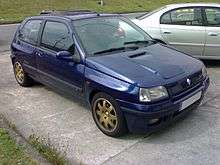

In 1993, Renault launched the Clio Williams as a limited edition of 3,800 cars (1,300 more than they needed for homologation purposes) with each car bearing a numbered plaque on the dash. These sold out so quickly that Renault ended up building 1,600 more.[7]
After the first series, due to the demand, Renault built the Williams 2 and 3, with more than 12,000 eventually being built. However, many new road cars were directly converted to race cars and when damaged replaced with another converted road car, which means that the actual number of road cars is significantly lower than the figures suggest.
The car was named after the then Renault-powered Formula One team WilliamsF1, though Williams had nothing to do with the design or engineering of this Clio. The modifications to the Clio 16S on which it was based were the work of Renault Sport, Renault's motorsport division. Nevertheless, this car had a Formula One link by being the sport's Safety Car in 1996.[8]
The naturally aspirated 1,998 cc (2.0 L; 121.9 cu in) DOHC 4 valves per cylinder fed by Multipoint fuel injection Inline-four engine, was rated at 147 PS (145 bhp; 108 kW) at 6,100 rpm and 175 N⋅m (129 lb⋅ft) at 4,500 rpm of torque. It has a top speed of 215 km/h (134 mph) [9] equipped with performance-tuned ride and handling. Renault later released the Williams 2 and Williams 3 special editions, much to the chagrin of those owners who had been assured of the exclusivity of the "original" Williams. One common mistake people can make is thinking that the 2.0 16V (F7R) used in the Williams is simply a bored out 1.8 16V (F7P), whereas, in reality the large engine had different size valves, cams, stroked crank and engine oil cooler. Other differences between the Williams and the Clio 16S it is based on include a wider front track with wishbones similar, but not the same as the Renault 19, wider Speedline alloys, uprated (JC5) gearbox, bespoke four-to-one manifold, firmer suspension, and some cosmetic differences on the exterior and interior.
The differences between the three versions of the Williams were largely a reflection of phase changes across the Clio range, e.g. the gradual addition of enhanced safety features and cosmetic variations. Other than this, the Williams 1 and 2 had no sunroof and were painted in 449 Sports Blue. The final Williams 3 was painted in a slightly brighter shade of blue (432 Monaco Blue) and finally gained a sunroof which had long been standard on virtually all previous Clios. The original Williams was the lightest of the three, lacking the electrics necessary for the sunroof or the mirrors, and was the only one to support a metal plaque stating the build number.
Respected motoring journalists consistently rate the Williams as one of the very best hot hatches ever made, regardless of era. Its many accolades included 3rd place in EVO magazine's "Greatest front-wheel-drive car ever" feature in 2006 behind the newer Clio 182 Trophy and Honda Integra Type-R and 6th place in EVO's Car Of The Decade feature in 2004.
The Renault Clio Williams was and still is a very popular rally car. The basic racing version (Gr.N) had racing suspension, different engine management, and a more free flowing exhaust. Power output was around 165 PS (121 kW). Roll cage was made by Matter France. Bucket seats were made by Sabelt.
The next step up was the Gr.A car, which was fitted with 16″ Speedline 2012 rims (with optional extractors), further improvements on suspension and more tuned engine producing between 205–220 PS (151–162 kW). Front brakes were also updated with 323 mm discs and four-pot Alcon brake calipers.
The final evolution was the Renault Clio Williams Maxi kit-car with wider arches and 17″ Speedline 2012 rims and improved Proflex suspension. Sodemo engine was further tuned to 250–265 PS (184–195 kW).
Engines
| Model | Engine | Displacement | Valvetrain | Fuel system | Max. power at rpm | Max. torque at rpm | Years |
|---|---|---|---|---|---|---|---|
| Petrol | |||||||
| 1.2 | E5F | 1171 cc | SOHC 8v | Carburettor | 54 PS (40 kW; 53 hp) at 6000 rpm | 83 N⋅m (61 lb⋅ft) at 3500 rpm | 1990–1993 |
| E7F | 1171 cc | Single-point fuel injection | 54 PS (40 kW; 53 hp) at 6000 rpm | 83 N⋅m (61 lb⋅ft) at 3500 rpm | 1990–1997 | ||
| C3G | 1171 cc | Single-point fuel injection | 54 PS (40 kW; 53 hp) at 6000 rpm | 83 N⋅m (61 lb⋅ft) at 3500 rpm | 1995–1996 | ||
| D7F | 1149 cc | Multi-point fuel injection | 54 PS (40 kW; 53 hp) at 5250 rpm | 93 N⋅m (69 lb⋅ft) at 2500 rpm | 1996–1998 | ||
| 58 PS (43 kW; 57 hp) at 5250 rpm | 93 N⋅m (69 lb⋅ft) at 2400 rpm | 1997–1998 | |||||
| 1.4 | E7J | 1390 cc | Single-point fuel injection | 75 PS (55 kW; 74 hp) at 5750 rpm | 107 N⋅m (79 lb⋅ft) at 3500 rpm | 1990–1998 | |
| 79 PS (58 kW; 78 hp) at 5750 rpm | 107 N⋅m (79 lb⋅ft) at 3500 rpm | 1996–1998 | |||||
| 1.7 | F2N | 1721 cc | 90 PS (66 kW; 89 hp) at 5750 rpm | 1990–1991 | |||
| 1.8 | F3P | 1794 cc | 88 PS (65 kW; 87 hp) at 5750 rpm | 142 N⋅m (105 lb⋅ft) at 2750 rpm | 1990–1996 | ||
| 1783 cc | 90 PS (66 kW; 89 hp) at 5750 rpm | 144 N⋅m (106 lb⋅ft) at 2750 rpm | 1996–1998 | ||||
| 1.8 RSi | 1794 cc | Multi-point fuel injection | 110 PS (81 kW; 110 hp) at 5500 rpm | 155 N⋅m (114 lb⋅ft) at 4250 rpm | 1993–1995 | ||
| 1783 cc | 107 PS (79 kW; 106 hp) at 5500 rpm | 150 N⋅m (111 lb⋅ft) at 2750 rpm | 1995–1998 | ||||
| 16S / 16V | F7P | 1764 cc | DOHC 16v | 137 PS (101 kW; 135 hp) at 6500 rpm | 158 N⋅m (117 lb⋅ft) at 4250 rpm | 1991–1995 | |
| 2.0 Clio Williams | F7R | 1998 cc | 150 PS (110 kW; 150 hp) at 6100 rpm | 175 N⋅m (129 lb⋅ft) at 4500 rpm | 1994–1998 | ||
| Diesel | |||||||
| 1.9 d | F8Q | 1870 cc | SOHC 8v | Indirect injection | 64 PS (47 kW; 63 hp) at 4500 rpm | 118 N⋅m (87 lb⋅ft) at 2250 rpm | 1991–1998 |
Clio II (1998)
| Clio II | |
|---|---|
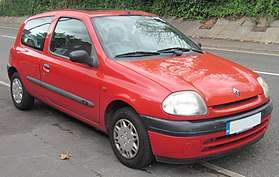 | |
| Overview | |
| Also called | Renault Clio Campus (UK, France, Germany, Colombia, Spain, Brazil) Renault Clio Grande (United Kingdom) Renault Clio Storia (Slovenia, Slovakia, Czech Republic, Italy) Renault Lutecia (Japan) Renault Clio New Basic (Denmark) Renault Symbol (Brazil) Renault Clio Mio (Argentina) Renault Novo Clio (Brazil) Renault Taxi Express (Colombia) Renault Clio Style (Colombia) Nissan Platina (Mexico) |
| Production | 1998–2012 (France)[10] 1998–2015 (Slovenia)[11] 2001–2009 (Mexico)[12][13][14] 2000–2017 (Argentina)[15][16] 2001–2017 (Colombia)[17][18] |
| Assembly |
|
| Designer | Patrick Le Quement (1993) |
| Body and chassis | |
| Body style | 3-door hatchback 5-door hatchback 4-door sedan |
| Platform | Alliance B platform |
| Related | Renault Symbol |
| Powertrain | |
| Engine | |
| Transmission | 5-speed manual 4-speed automatic |
| Dimensions | |
| Wheelbase | 2,472 mm (97.3 in) |
| Length | 3,773 mm (148.5 in) (1998–01) 4,150 mm (163.4 in) (1998–01 sedan) 3,811 mm (150.0 in) (2001–12) 4,171 mm (164.2 in) (2001–08 sedan) |
| Width | 1,639 mm (64.5 in) |
| Height | 1,417 mm (55.8 in) (hatchback) 1,437 mm (56.6 in) (sedan) |
| Curb weight | 990 kg (2,183 lb) |
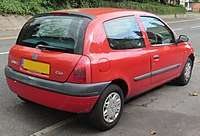
_3-door_hatchback_(2015-07-24)_01.jpg)
_3-door_hatchback_(25696139476).jpg)

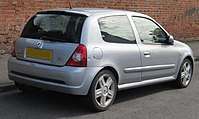
Development of the X65 commenced in 1991, a year after the May 1990 launch of the Clio. In 1992, Pierre Beuzit became project manager of the X65 programme. In December 1993, a final design developed under Patrick Le Quement was approved, with development for production commencing, so in 1994 Renault rented a 129,600-square-foot building in Saint-Quentin-en-Yvelines, west of Paris. More than 600 people from Renault and its suppliers went to work there. The X65 project team became a laboratory for Renault's Guyancourt technical center. Forty teams were created, each responsible for a section of the car. In February 1997, management moved market launch by over 1 month from 15 March 1998 to 11 April 1998. Development ended in 1997, as pre-production units began to be constructed at Flins.[20][21][22]
The second generation of the Clio was launched on 9 March 1998 and sold for less than €8,000, with considerably more rounded and bulbous styling than its predecessor. Part of the radical concept of the new Clio were many components made of unusual materials to save in weight and repair costs. For instance, the front wings were made of plastic (following criticisms of corrosion in this part of the previous model and based on technology developed for the Renault Espace) and the material of the bonnet was aluminium in some versions. Originally the engine lineup was similar to before, with 1.2 L, 1.4 L and 1.6 L petrol engines and a 1.9 L diesel. The project manager from 1992-98 for the Clio II was Pierre Beuzit.
In early 2000, a sportive 16V version equipped with a new 1.6 L 16-valve engine was introduced, and eventually, all the older petrol engines were upgraded to more powerful and more economical 16-valve versions.[23]
In 1998, Renault launched the 169 PS (124 kW) Clio Renault Sport (also known as Clio RS for short, named Clio Renault Sport 172 in the UK and sold for less than €17,500 — 172 coming from the DIN method metric horsepower measurement), with a 2.0 L 16-valve engine and a top speed of 220 km/h (137 mph). The standard Clio RTE powered with by the 1.2 54 PS (40 kW) engine could reach 160 km/h. The top-of-the-range Clio, however, was the 2001 mid-engined, rear-wheel drive Clio V6 Renault Sport, originally engineered by Tom Walkinshaw Racing for a one-make racing series, which placed a 230 PS (169 kW) 3.0 L V6 engine, sourced from the Renault Laguna, behind the front seats, with a top speed of 235 km/h (146 mph).Production was at the TWR factory in Sweden. Production over 3 years was approximately 1513 vehicles with 256 sold in the UK.
In 2000, a few minor changes were made to the Clio range, which included revised specification levels, a new instrument cluster, and a passenger airbag fitted as standard for all models. The Clio achieved a four-star Euro NCAP rating in 2000,[24] which was class-leading at the time.[25]
In Japan, Renault was formerly licensed by Yanase Co., Ltd., but in 1999, Renault purchased a stake in Japanese automaker Nissan after Nissan had faced financial troubles following the collapse of the Japanese asset price bubble in 1991 and subsequent Lost Decade. As a result of Renault's purchase of interest, Yanase canceled its licensing contract with Renault in the spring of 2000, and Nissan took over as the sole licensee, hence sales of the Lutecia II in Japan were transferred from Yanase Store locations to Nissan Red Stage Store locations.
Facelifts
- 2001
A major facelift occurred in June 2001 (Phase 2) which saw the exterior restyled (most visibly the headlights were made more angular), the interior quality improved with a new dashboard and centre console including the availability of digital climate control air-conditioning and satellite navigation on top models and a 1.5 L common rail Diesel engine added.
- 2003
Major revisions were made to the mid-engine 3.0 litre V6 model in line with the facelift introduced to the regular models in 2001 including revised frontal styling, new dashboard and higher equipment levels including climate control, cruise control and xenon headlights. The power output of the engine was raised by 25 PS (18 kW) to 255 PS (188 kW), giving it a top speed of 153 mph (246 km/h) and a 0-62 mph (100 km/h) time of 5.8 seconds. Emissions are 285g/km and meet Euro IV standards 2 years before the implementation deadline. The chassis was also significantly revised with a slightly longer wheelbase and revised suspension together with larger 18 inch alloy wheels. For the Phase 2 V6, production was transferred from TWR's Swedish factory to the dedicated Renault Sport Alpine factory at Dieppe in Northern France. Production from 2003 to the end of 2005 was approximately 1309 vehicles of which 354 were sold in the UK.
- 2004
In 2004, Phase 3 followed starting on a 53 Plate, this was just some small changes to bring it up to date. The front bumper was changed giving it a wide lower grille and the foglights were bulged out at the side (cars not equipped with foglights remained using the older ph2 bumper), the upper grille was changed and the headlights (which previously had black background) now had grey. The 15" alloy wheels were changed and were now a 15" version of the facelift 172 model on Dynamique and Extreme models. Clear side repeaters were added, as was a colourcoded rear spoiler (again on Dynamique spec cars). In the South American market, the facelifted Clio continued to use the dashboard of the 1998 model and was never updated, except for the Colombian 2008 model that included the same interior of the European version with little changes, and continued having the same exterior as the phase II model.
On the inside the pattern on the seats was changed for a simpler one, and the dials were changed to do away with the fuel and water temperature needles and now featured a larger screen that included a digital version of these gauges as well as the mileage and trip computer. Climate control equipped cars were given a vent in the back of the glove box so it could be climate controlled. Under the bonnet a new 100 PS (74 kW) dCi engine was available (the 1.2 16v also received a new engine developed with Nissan). Rear disks were fitted on 1.6 16v models and DCi 100 models equipped with ESP. On this second facelift, the Clio Renault Sport's power was improved to 182 PS (134 kW) (in the UK, the designation RS 182 was adopted). For the first time there were two options in chassis stiffness for the RS model. the standard Settings (different from the non-sport models), and CUP badge chassis, 20 mm lower, larger stabilizer bars, and stiffer suspension with dark graphite alloy wheels.
At the 2006 Paris International Agricultural Show, Renault exhibited a Hi-Flex Clio II with a 1.6 L 16-valve engine. This vehicle, which addresses the Brazilian market, features Renault-developed flex-fuel technology, with a highly versatile engine that can run on fuel containing a blend of petrol and ethanol in any proportion (0% to 100% of either).
- 2006
_%E2%80%93_Frontansicht%2C_1._September_2012%2C_Heiligenhaus.jpg)
_%E2%80%93_Heckansicht%2C_1._September_2012%2C_Heiligenhaus.jpg)
The Phase 4 Clio II, known as the Clio Campus, was introduced in 2006 and had a restyled rear end, the number plate moving from boot to bumper, and a better specification on all models.[26] This car stopped being sold in the UK in late 2008, and a revised front end was then released in April 2009 (Phase 5).[27]
The last units of the Clio II built in Mexico featured the headlights used on the Nissan Platina, thus becoming the third headlight design to be used in the car. This version lasted a month (January 2010) on sale, before both Clio and Platina being replaced by the Dacia Logan and Sandero. The second generation Clio was marketed until 2012 in France as the Clio Campus,[28] or in Slovenia as the Clio Storia.[29] It is still marketed in Colombia also as Clio Campus since 2012, with the same interior as the pre-facelifted model and a very basic equipment, without airbags or foglights.
- 2012
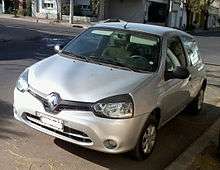
In October 2012, a new version of the Clio II, called Clio Mío,[30] was introduced at the São Paulo Motor Show, featuring the brand's new design theme.[31] Intended to be the lowest priced Renault model available in Latin America,[32] it was manufactured in Córdoba, Argentina,[33] and featured additional styling and equipment updates. It kept the dashboard of the pre-facelift version, but with new gauges and optional color matching inserts.[32] It was finally retired from production in October 2016.[34]
Sedan
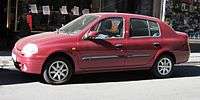
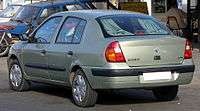
In 1999, Renault launched the saloon version of the Clio II, named Clio Symbol in Turkey and Eastern Europe, Thalia in Central Europe, Clio Classic in Asia and North Africa, Clio Sedan in Brazil and Paraguay, or Symbol in the rest of South America (except Argentina where it was called Clio). The car was intended for sale in developing countries, where saloons were traditionally preferred over hatchbacks, most notably in Eastern Europe, where the Thalia was cheaper than the Clio, but was still about 30% more expensive than the Dacia Logan, also sold by Renault as a low cost model. In some Latin American markets the sedan was offered as the Nissan Platina (manufactured in Aguascalientes, Mexico), with slight changes in the front of the car to make it resemble the Nissan Altima. The sedan version of the Clio was facelifted in 2002, with new exterior similar to the facelifted Clio, better equipment and safety levels.
In the fall of 2006, an improved Clio sedan has been offered, renamed in Eastern Europe as Renault Symbol. This model featured the interior of the facelifted Clio II with very minor parts commonality with Megane II, as well as new standard and optional equipment, such as automatic air conditioning and a CD player. The model earned moderate reception in the domestic market.
Renault introduced the second generation of the Symbol model at the 2008 Moscow Motor Show. This new model featured chrome-trimmed front grille and rear fascia, while powered by similar engines as the Dacia Logan range. It was designed for the Eastern and Central Europe, Russia, Turkey and North Africa, and it was also manufactured in Argentina for South America.
Watchdog controversy
In April 2006, the BBC's consumer affairs programme Watchdog aired details of over 1,000 incidents involving Clio IIs in which the bonnet flew open without warning while still being driven, usually at high speeds, and sometimes writing the cars off. The problem was found to be caused by the catch not being cleaned and lubricated during servicing causing it to stick in the open position. Renault investigated the issue with the aid of the Vehicle and Operator Services Agency (VOSA) and a "task force" of Renault departments to test the design but found no problem with the bonnet catch and so would not issue a recall. Renault instead wrote to owners of the model and offered to "remedy for free any catches where there has been poor maintenance".[35]
Watchdog has since claimed other experts have contacted them with accusations that Renault was expecting people to maintain a flawed part that would corrode over time and could cost lives. David Burrowes, MP, Chair of the Government's Road Safety Group, later tabled a motion in the House of Commons urging further action. Renault was accused by its Press Relations Manager Graeme Holt, who quit in protest, of downplaying the serious "fault" and putting customers' lives in danger.[36]
Engines
| Model | Code | Valvetrain | Displacement | Max. power | Max. torque | Availability |
|---|---|---|---|---|---|---|
| Petrol | ||||||
| 1.0 | D7D | SOHC 8v | 999 cc | 59 PS (43 kW; 58 hp) at 5500 rpm | 81 N.m at 4,250 rpm | Brazil, 2000–2007 |
| D4D | DOHC 16v | 76 PS (56 kW; 75 hp) at 6000 rpm | 95 N.m at 4250 rpm | Brazil, 2003–2005 | ||
| 1.0
(Petrol/Ethanol) |
77 PS (57 kW; 76 hp) at 6000 rpm | 100 N.m at 4,250 rpm | Brazil, 2006–2012 | |||
| 80 PS (59 kW; 79 hp) at 5,750 rpm | 103 N.m at 4,250 rpm | Brazil, 2013–2016 | ||||
| 1.2 | D7F | SOHC 8v | 1149 cc | 58 PS (43 kW; 57 hp) at 5,250 rpm | 93 N⋅m (69 lb⋅ft) at 2,500 rpm | 1998–2012 |
| D4F 712 | DOHC 16v | 1149 cc | 75 PS (55 kW; 74 hp) at 5,500 rpm | 105 N⋅m (77 lb⋅ft) at 3,500 rpm | 2001-2004 | |
| D4F 722 | DOHC 16v | 1149 cc | 75 PS (55 kW; 74 hp) at 5,500 rpm | 107 N⋅m (79 lb⋅ft) at 4,250 rpm | 2004-2012 | |
| 1.4 | E7J | SOHC 8v | 1390 cc | 75 PS (55 kW; 74 hp) at 5,500 rpm | 114 N⋅m (84 lb⋅ft) at 4,250 rpm | 1991–2001 |
| K7J | SOHC 8v | 1390 cc | 75 PS (55 kW; 74 hp) at 5,500 rpm | 114 N⋅m (84 lb⋅ft) at 4,250 rpm | 1998–2001 | |
| K4J | DOHC 16v | 1390 cc | 95 PS (70 kW; 94 hp) at 6,000 rpm | 127 N⋅m (94 lb⋅ft) at 3,750 rpm | 1999-2000 | |
| K4J 710 | DOHC 16v | 1390 cc | 98 PS (72 kW; 97 hp) at 6,000 rpm | 127 N⋅m (94 lb⋅ft) at 3,750 rpm | 2000-2005 | |
| 1.6 | K7M 744 | SOHC 8v | 1598 cc | 90 PS (66 kW; 89 hp) at 5,250 rpm | 131 N⋅m (97 lb⋅ft) at 2,500 rpm | 1998-2000 |
| K4M | DOHC 16v | 1598 cc | 110 PS (81 kW; 108 hp) at 5,750 rpm | 148 N⋅m (109 lb⋅ft) at 3,750 rpm | 1999-2005 | |
| 1.6 (Petrol/Ethanol) | 115 PS (85 kW; 113 hp) at 5,750 rpm | 157 N.m at 3,750 rpm | Brazil, 2005–2009 | |||
| 2.0 RS | F4R 736 | DOHC 16v | 1998 cc | 172 PS (127 kW; 170 hp) at 6,250 rpm | 200 N⋅m (148 lb⋅ft) at 5,400 rpm | 1999-2004 |
| 2.0 RS 182 | F4R 738 | DOHC 16v | 1998 cc | 182 PS (134 kW; 180 hp) at 6,250 rpm | 200 N⋅m (148 lb⋅ft) at 5,250 rpm | 2004-2006 |
| 3.0 RS V6 | L7X | DOHC 24v | 2946 cc | 230 PS (169 kW; 227 hp) at 6,000 rpm | 300 N⋅m (221 lb⋅ft) at 3,750 rpm | 2000-2002 |
| 3.0 RS V6 | L7X | DOHC 24v | 2946 cc | 255 PS (188 kW; 252 hp) at 7,150 rpm | 300 N⋅m (221 lb⋅ft) at 4,650 rpm | 2003-2005 |
| Diesel | ||||||
| 1.5 dCi | K9K | SOHC 8v | 1461 cc | 64 PS (47 kW; 63 hp) at 3,750 rpm | 160 N⋅m (118 lb⋅ft) at 1,900 rpm | 2009–2012 |
| 1.5 dCi | K9K | SOHC 8v | 1461 cc | 65 PS (48 kW; 64 hp) at 4,000 rpm | 160 N⋅m (118 lb⋅ft) at 2,000 rpm | 2001–2005 |
| 1.5 dCi | K9K | SOHC 8v | 1461 cc | 68 PS (50 kW; 67 hp) at 4,000 rpm | 160 N⋅m (118 lb⋅ft) at 1,500 rpm | 2006–2007 |
| 1.5 dCi | K9K | SOHC 8v | 1461 cc | 82 PS (60 kW; 81 hp) at 4,000 rpm | 185 N⋅m (136 lb⋅ft) at 2,000 rpm | 2002–2005 |
| 1.5 dCi | K9K | SOHC 8v | 1461 cc | 100 PS (74 kW; 99 hp) at 4,000 rpm | 200 N⋅m (148 lb⋅ft) at 1,900 rpm | 2004–2005 |
| 1.9 dTi | F9Q | SOHC 8v | 1870 cc | 80 PS (59 kW; 79 hp) at 4,000 rpm | 160 N⋅m (118 lb⋅ft) at 2,900 rpm | 2000–2001 |
Clio III (2005)
| Clio III | |
|---|---|
| Overview | |
| Also called | Renault Euro Clio (Mexico) Renault Lutecia (Japan) |
| Production | 2005–2014[33][37][38] |
| Assembly |
|
| Body and chassis | |
| Body style | 3-door hatchback 5-door hatchback 5-door estate |
| Platform | Alliance B platform |
| Related | Nissan Micra Nissan Tiida Renault Modus Dacia Logan Dacia Sandero |
| Powertrain | |
| Engine | |
| Transmission | 5-speed manual 6-speed manual 4-speed automatic |
| Dimensions | |
| Wheelbase | 2,451 mm (96.5 in) 2,575 mm (101.4 in) (estate) |
| Length | 3,986 mm (156.9 in) (2005–09) 4,032 mm (158.7 in) (2009–present) 4,233 mm (166.7 in) (estate) |
| Width | 1,707 mm (67.2 in) (2005–09) 1,720 mm (67.7 in) (2009–present) 1,719 mm (67.7 in) (estate) |
| Height | 1,497 mm (58.9 in) |
| Curb weight | 1,150 kg (2,535 lb) |

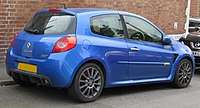
The third generation Clio was unveiled at the 2005 Frankfurt Motor Show.[39]
The Clio III uses the Nissan B platform, co-developed with Nissan (which Renault has a share in), that is shared with the Renault Modus, the Nissan Micra and the Nissan Note. It is considerably larger and 130 kg (287 lb) heavier as well as being more expensive than the Clio II, and, at nearly 4,000 mm (157 in) in length, has almost outgrown the supermini class.
This was the result of a decision to move the Clio upmarket. It also brings the trademark "Renault Card" keyless immobiliser to the Clio for the first time. The new Clio achieved a 5-star EuroNCAP safety rating, joining the rest of Renault's family at the maximum safety rating (with the exception of the Kangoo and the Twingo). Sales began throughout Europe in October 2005.
It was voted European Car of the Year 2006, becoming the first car to win twice, defeating the rival Volkswagen Passat by just 5 points. The Clio was described by several people as the new benchmark for its category and by one judge as a "great little car that should inspire bigger ones". The trophy for the award was presented in January 2006 to the Renault chief executive at a ceremony in Italy organized by Auto Magazine.[40]
In June 2006 the sales of the third generation Clio Renault Sport started in France for the price of €23,000. The Clio Renault Sport is equipped with a new naturally aspirated 16-valve 2.0 L engine based on the earlier version used in the second generation Clio Renaultsport and a 6-speed manual gearbox. The engine develops 197 PS (145 kW) at 7250 rpm. The top speed is 215 km/h (134 mph) and 0–100 km/h (62 mph) takes 6.9 seconds.
An estate version called Sport Tourer was unveiled in March 2007. At the same time, Renault replaced the 1.4 L atmospheric engine with a new turbocharged 1.2 TCe version, with 101 PS (74 kW) and 145 N⋅m (107 lb⋅ft) of torque. In the 2nd, 3rd and 4th gears over 4500 rpm the turbocharger adds 5 extra HP.
Unlike its predecessors, the Japanese-spec Renault Lutecia III was not available at any Yanase Co., Ltd. dealership location, as Yanase had ended its import rights for Renault after Renault had acquired a stake in Nissan when the Lutecia II was still in production. Instead, the Renault Lutecia III was sold exclusively through Nissan Red Stage Store locations.
Facelift
2009
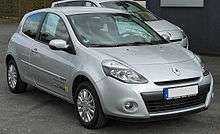
_%E2%80%93_Heckansicht%2C_11._Juni_2011%2C_W%C3%BClfrath.jpg)
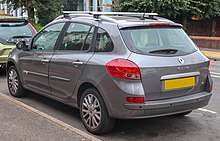
A facelifted version of the Clio III went on sale in the United Kingdom on 15 May 2009.
It features better quality materials used in the interior and is better equipped than the pre-facelift model.[41]
It is also introduced with a new Clio RS variant, intended to slot between the regular Clio and the Clio 182 RS
The Clio GT has a new aggressive front end styling incorporating a black grille, extended side sills, suspension settings unique to the RS variant, and a twin tailpipe design with a lip spoiler on the rear end.[42]
The Renault Clio III also became the basis for the Renault Clio Gordini 20-34 (limited edition) introduced in the United Kingdom in 2010. The Clio Gordini 200 is equipped with a 2.0L F4R engine which develops 200 CV (147 kW; 197 hp; 200 PS). However, the limited edition is priced as low as the usual version.[43]
The range was reduced in late 2012, due to the launch of the Clio IV. However, in France and Spain it remained in the range as the Clio Collection and was in production until 2014.[33]
Engines
| Model | Code | Valvetrain | Displacement | Max. power | Max. torque | Availability |
|---|---|---|---|---|---|---|
| Petrol | ||||||
| 1.2 L | D4F 740 | DOHC 16v | 1149 cc | 76 PS (56 kW; 75 hp) | KR0x | |
| 1.2 L TCe 100 | D4FT | DOHC 16v | 1149 cc | 101 PS (74 kW; 100 hp) | 2007– | |
| 1.4 L | K4J | DOHC 16v | 1390 cc | 98 PS (72 kW; 97 hp) | BR0x | |
| 1.6 L | K4M | DOHC 16v | 1598 cc | 110 PS (81 kW; 108 hp) | ||
| 1.6 L | K4M | DOHC 16v | 1598 cc | 112 PS (82 kW; 110 hp) | 2005– | |
| 1.6 L | K4M | DOHC 16v | 1598 cc | 130 PS (96 kW; 128 hp) | 2009-2012 | |
| 2.0 L | M4R | DOHC 16v | 1997 cc | 138 PS (101 kW; 136 hp) | C/BR0x | |
| 2.0 L | F4R 830 | DOHC 16v | 1997 cc | 197 PS (145 kW; 194 hp) | RS, 2006–09 | |
| 2.0 L | F4R 832 | DOHC 16v | 1997 cc | 204 PS (150 kW; 201 hp) | RS, 2010- | |
| Diesel | ||||||
| 1.5 L dCi | K9K | SOHC 8v | 1461 cc | 68 PS (50 kW; 67 hp) | 2005– | |
| 1.5 L dCi | K9K | SOHC 8v | 1461 cc | 86 PS (63 kW; 85 hp) | 2005– | |
| 1.5 L dCi | K9K | SOHC 8v | 1461 cc | 90 PS (66 kW; 89 hp) | 2011– | |
| 1.5 L dCi | K9K | SOHC 8v | 1461 cc | 106 PS (78 kW; 105 hp) | 2005– | |
Clio IV (2012)
| Clio IV | |
|---|---|
_%E2%80%93_Frontansicht%2C_17._Mai_2013%2C_M%C3%BCnster.jpg) | |
| Overview | |
| Also called | Renault Lutecia (Japan)[2] |
| Production | 2012–2019 |
| Assembly |
|
| Designer | Laurens van den Acker |
| Body and chassis | |
| Body style | 5-door hatchback 5-door estate |
| Platform | Alliance B platform |
| Related | Renault Captur Nissan Micra V Renault Clio R.S. |
| Powertrain | |
| Engine | |
| Transmission | 5-speed manual 6-speed automatic |
| Dimensions | |
| Wheelbase | 2,589 mm (101.9 in) |
| Length | 4,062 mm (159.9 in) (hatchback) 4,262 mm (167.8 in) (estate) |
| Width | 1,732 mm (68.2 in) |
| Height | 1,448 mm (57.0 in) |
| Curb weight | 980–1,071 kg (2,161–2,361 lb) |
_%E2%80%93_Heckansicht%2C_17._Mai_2013%2C_M%C3%BCnster.jpg)
.jpg)
The Clio IV was introduced at the September–October 2012 Paris Motor Show,[45] and began marketing a month later. It is available in hatchback body style and starting from early 2013 also as an estate.[46] It is manufactured in Flins, France, and in Bursa, Turkey,[47] where the estate will particularly be assembled.[48]
The Clio IV is only available with five doors, with "hidden" rear door handles near the windows. Another notable difference from the previous generation is the wheelbase, which has been significantly extended and is now near to the one of a compact car. The length and the width have also been increased, but less significantly.
The RS version was launched in Mexico in 2014, and is the only French product in Renault's Mexican lineup.[49]
A brief time line for the Clio IV (based on the French market)
- OCT. 2012 Introduced with Authentique, Expression and Dynamique
- MAR. 2013 Introduced Estate (Authentique, Expression and Dynamique)
- APR. 2013 Renamed to Life, ZEN and Intens also added GT.
- SEP. 2013 Added dCi EDC
- JAN. 2014 Added 1.2 16V (D4F) GPL
- OCT. 2014 Added Initial Paris
- MAR. 2015 Added GT-Line (Pack Option), added Ivory paint and deleted Yellow.
- JUL. 2015 Minor update for dashboard and steering wheel for Intens.
- APR. 2016 GT discontinued.
- AUG. 2016 Introduced Phase 2.
- MAY. 2018 Added 0.9 TCe 75.
- JUL. 2018 Reorganize version to Trend, Limited and Intens.
- APR. 2019 After the commercialization of the Clio V , the Clio IV continues to be produced under the designation "Clio Generation" with only two engine specs. 0.9L TCe 70 and TCe 90.
Features
The Clio IV features new equipment such as hands-free, rear camera connectivity with more than 50 applications (Renault R-Link 7-inch infotainment system, powered by Android & TomTom)[50] and a six-speed dual-clutch transmission that will be available starting early 2013.[51]
Engines
The range of petrol engines consists of three options: a 1.2-litre 16 valve straight-4 engine, with a maximum power output of 75 hp (56 kW), a turbocharged 0.9-litre 12 valve straight-3 engine, developing 90 hp (67 kW), which can have a CO
2 emission level of 99 g/km and a 1.2 litre turbocharged engine which produces 120 hp (89 kW). A turbocharged 1.6-litre four-cylinder engine, capable of producing 197 hp (147 kW), will be featured on the Renault Sport version.[52]
The diesel range has two versions of the 1.5 dCi straight-4 engine, one of 75 hp (56 kW) and one of 90 hp (67 kW), which can have a CO
2 emission level of 83 g/km.[53]
| Engine | Code | Displacement | Power | Torque | Top speed | 0–100 km/h (0-62 mph) | Combined consumption[note 1] | CO 2 emissions |
|---|---|---|---|---|---|---|---|---|
| Petrol engines | ||||||||
| 0.9 12v Energy TCe | H4Bt 400 | 898 cc | 90 hp (67 kW) at 5250 rpm | 135 N⋅m (100 lb⋅ft) at 2500 rpm | 182 km/h (113 mph) | 12.2 s | 4.5 l/100 km (63 mpg‑imp) | 104 g/km |
| 0.9 12v Energy TCe 99g | 185 km/h (115 mph) | 13.0 s | 4.3 l/100 km (66 mpg‑imp) | 99 g/km | ||||
| 1.2 16v 75 | D4F 740 | 1,149 cc | 75 hp (56 kW) at 5500 rpm | 107 N⋅m (79 lb⋅ft) at 4250 rpm | 167 km/h (104 mph) | 14.5 s | 5.5 l/100 km (51 mpg‑imp) | 127 g/km |
| 1.2 16v TCe 120 | H5Ft | 1,149 cc | 119 hp (89 kW) at 4900 rpm | 190 N⋅m (140 lb⋅ft) at 2000 rpm | 199 km/h (124 mph) | 9.4 s | 5.2 l/100 km (54 mpg‑imp) | 120 g/km |
| 1.2 16v Energy TCe 120[54] | H5Ft | 1,197 cc | 118 hp (88 kW) at 5500 rpm | 205 N⋅m (151 lb⋅ft) at 2000 rpm | 199 km/h (124 mph) | 9.0 s | 5.3 l/100 km (53 mpg‑imp) | 118 g/km |
| Diesel engines | ||||||||
| 1.5 8v dCi 75 | K9K 612 | 1,461 cc | 75 hp (56 kW) at 4000 rpm | 200 N⋅m (148 lb⋅ft) at 1750 rpm | 168 km/h (104 mph) | 14.3 s | 3.6 l/100 km (78 mpg‑imp) | 95 g/km |
| 1.5 8v Energy dCi 90 | K9K 608 | 90 hp (67 kW) at 4000 rpm | 220 N⋅m (162 lb⋅ft) at 1750 rpm | 178 km/h (111 mph) | 11.7 s | 3.4 l/100 km (83 mpg‑imp) | 90 g/km | |
| 1.5 8v Energy dCi 90 83g | 180 km/h (112 mph) | 12.1 s | 3.2 l/100 km (88 mpg‑imp) | 83 g/km | ||||
- It uses 20% more fuel than advertised. Citroen C1 cars use far more fuel than makers claim, according to new research - Mirror Online
The 1.5 dCi 110cv is now available for the Clio too. The Clio has been facelifted with a new badge and a new estate was launched.
Clio V (2019)
| Clio V | |
|---|---|
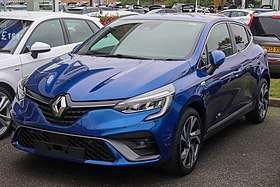 | |
| Overview | |
| Production | 2019–present |
| Designer | Laurens van den Acker |
| Body and chassis | |
| Body style | 5-door hatchback |
| Platform | CMF-B[55] |
| Related | Renault Captur II Nissan Juke |
| Powertrain | |
| Engine | |
| Transmission | 5-speed manual 6-speed manual 7-speed automatic Multimode CVT (E-Tech PHEV) |
| Dimensions | |
| Wheelbase | 2,583 mm (101.7 in) |
| Length | 4,048 mm (159.4 in) |
| Width | 1,798 mm (70.8 in) |
| Height | 1,440 mm (56.7 in) |

The fifth generation model was unveiled at the 2019 Geneva Motor Show.
Powertrain
The car will be available with a plenty of choices of engines & gearbox from the beginning. The new modular CMF-B platform also helps to improve efficiency in the new Clio, which offers the option of a hybrid powertrain for the first time. Available from 2020, the E-Tech hybrid drivetrain combines a new-generation 1.6-litre petrol engine with two electric motors, a multi-mode gearbox, and a 1.2 kWh battery. No exact specs of the Clio E-Tech have been released but the hybrid setup is said to provide “maximum efficiency in use with class-leading responsiveness, limited energy waste and quick battery charging when decelerating.
The conventional engine lineup includes new turbocharged petrol (1.0 TCe 100 and 1.3 TCe 130) engines, along with the naturally aspirated 1.0 SCe, as well as the Blue dCi 1.5-litre diesel with an output of 85 hp. In total, customers will be able to choose from nine engine/gearbox combinations.
Equipment
The new model comes with an interior that uses higher quality material and finishes (for higher trim levels), sporty seats, a large 9.3-inch touch screen display (with the Easy Link system, compatible with Android Auto and Apple CarPlay and featuring Google Maps and TomTom navigation), customizable driver screen (instrument cluster) made of a TFT display, a redesigned, more compact steering wheel, electric handbrake (for the RS Line equipment level), wireless smartphone charger (option for the RS Line trim level), LED headlights (with automatic main beam activation, on select models), hands free parking, 360-degree system of four cameras, lane keeping assistant, adaptive cruise control and road sign recognition, blind spot warning and automatic emergency braking.[57][58]
Advertising
- In the United Kingdom, the Clio was advertised on television using the characters "Nicole" (a flirtatious young French woman played by Estelle Skornik) and "Papa" (her somewhat slow-witted father played by Max Douchin). The 1994 advert featured Vincent Cassel as Nicole's boyfriend. The commercials were very popular, with the final instalment of the series featuring comedy double act Bob Mortimer and Vic Reeves, in a sequence parodying The Graduate. In 2000, the 1991 commercial "Interesting" was named the 12th best television commercial of all time, in a poll conducted by The Sunday Times and Channel 4. Sound clips of the advert were played repeatedly on The Chris Moyles Show when it was discovered Comedy Dave and his girlfriend had named their newborn daughter Nicole.
- In 1999, a television advert was launched worldwide for the Renault Clio MTV Limited edition featuring a man who was saying "Get up ah!" all the time, it was actually the only sound he can hear from a Clio passing in front of his house early in the morning, then the advert shows the five men inside the Clio and moving their heads to the rhythm of the James Brown song "Get Up (I Feel Like Being a) Sex Machine". Same advertising made in Argentina with the Clio II in 2000 with this song.[59]
- The Clio II advertising campaign featured French model Hélène Mahieu, and French international footballer Thierry Henry for the Clio II facelift, both attempting to define the term va-va-voom, a term later defined by the Oxford English Dictionary as "The quality of being exciting, vigorous, or sexually attractive", although they state that it dates from the 1950s. In Brazil, the Clio had a trim level called Va Va Voom. The trim level has been discontinued. In Mexico, The Clio II's latest campaign reads "todo por mi Clio" (anything for my Clio), depicting one would give anything to keep one's Clio safe from danger.
- The Renault Clio RS 200 EDC hatchback was one of the many vehicles that can be unlocked in Asphalt 8 with a certain amount of coins in the game.
- The latest campaign to date for the Clio was for the Renault Clio III, which featured French actress Annelise Hesme and English actor Jeremy Sheffield as Sophie and Ben (respectively), trying to outdo each other over the superiority of each nation via a range of cultural aspects. This "France Vs Britain" (French car, British designers) campaign has been extended across a number of media, for example the "French Film, British Cinemas" tag for the annual Renault French Film Festival. The music used is Nina Simone's "Sinnerman".
Motorsport
The Clio has competed in various well-known races and championships such as the Spa 24 hours and British GT. The car competed in the Spa 24 hour race in 1991, 1992, 1993, 1995, 1999 and 2000. Atlanta Motorsport competed in the GT Cup class in 2003 and 2004, both times at Donington Park. The Clio has also been entered in the Nürburgring 24 Hours and Zolder 24 Hours with varying amounts of success.
In 2001, Rob Collard entered the BTCC with a Renault Clio in the Production class, which were made up of slower, smaller cars like the Peugeot 306 GTi, the Ford Focus and Honda Accord. Throughout the season, Collard was a common contender in the middle of the field in most races. He was often seen amongst the lower-scoring Peugeot 306s like Tom Boardman and Paul O'Neill. At the end of the season, despite not participating in nine races and getting only eight finishes, initially, he finished 12th with 51 points, but due to a penalty of 5 points, his final position in the championship standings was 13th with 46 points. He scored one podium in the first race at Snetterton, with a 5th place finish.
In 2002, Collard entered again with the Clio for the next season. Unfortunately, out of the ten races he was entered in, he only started four, with the three he finished resulted in him ending up on the podium with a 2nd place in class (7th overall) and a 1st place in class (9th overall) at the first event of the season. After four non-starts at Oulton Park and Thruxton, Collard finished 2nd in class (14th overall) at Silverstone in the first race, later retiring from the second. His last entry in the Clio was at Croft where he didn't start either race. By the end of the season, he initially had 39 points, but 5 were redacted, he remained in his 12th place finish in the championship standings with 34 points.[60]
Awards
- European Car of the Year in 1991
- European Car of the Year in 2006
- What Car? "Supermini of the Year" 2006
- Winner of El Mejor Automóvil Subcompacto (Best supermini) on Automóvil Panamericano magazine in 2002, 2003 and 2004 in Mexico
References
- "Renault's New Clio III: Up to 53.5 MPG". Green Car Congress. 26 June 2005. Retrieved 9 July 2010.
- "Model lineup: Renault Lutecia presentation" (in Japanese). Renault Japon. Retrieved 12 November 2013.
- "Mixed Results in the 1990s". Renault Argentina. Retrieved 11 September 2011.
The following year [1995] [...] the company responded by [...] introducing new models, including the mid-sized Mégane and the subcompact Clio.
- Büschi, Hans-Ulrich, ed. (10 March 1994). Automobil Revue 1994 (in German and French). 89. Berne, Switzerland: Hallwag AG. p. 475. ISBN 3-444-00584-9.
- Büschi, Hans-Ulrich, ed. (5 March 1992). Automobil Revue 1992 (in German and French). 87. Berne, Switzerland: Hallwag AG. p. 490. ISBN 3-444-00539-3.
- "Rewind to 1991: Renault Clio". Quicks. Archived from the original on 9 January 2014. Retrieved 9 January 2014.
- "Frank Williams put his name on a Clio". Ran When Parked. Archived from the original on 24 October 2011. Retrieved 19 July 2011.
- http://www.carmagazine.co.uk/features/top-10s/the-car-top-10-f1-safety-cars/ Jan Conesa Sagrera, "The CAR Top 10: F1 safety cars", Car Magazine, 3 April 2015
- "1993 Renault Clio Williams". carfolio.com. Retrieved 18 June 2018.
- "Renault Clio Campus Bye Bye". Renault. 6 January 2012. Retrieved 15 February 2012.
- "Production of Clio returning to Renault plant in Novo mesto". The Slovenia Times. 17 March 2016.
The Novo mesto plant had produced Clio models from 1993 until last year, but then focused on the joint Renault-Daimler project of building the Twingo and Smart forfour.
- "2001 Annual Report" (PDF). Renault. 16 May 2002. Retrieved 25 March 2016.
In Mexico, Scénic has been built at Nissan's Cuernavaca plant since 2000, and Clio went into production at Nissan's Aguascalientes plant late in 2001.
- "Renault México" (in Spanish). Archived from the original on 27 March 2016. Retrieved 25 March 2016.
Diciembre 2001: inicio de producción del modelo Clio en la planta de Aguascalientes de Nissan.
- "Queda descontinuado el Renault Clio en este 2010" (in Spanish). Alvolante.info. 7 January 2010.
- "Renault en Argentina" (in Spanish). Renault Argentina. Archived from the original on 28 August 2003. Retrieved 26 September 2011.
El lanzamiento de Mégane 2 en octubre de 1999 y de Clio 2 en marzo de 2000 rejuveneció la gama de productos nacionales.
- "Cordoba Plant". Renault. Archived from the original on 6 January 2017. Retrieved 25 March 2016.
Models built: Clio II, Kangoo & Kangoo Express, Symbol, Fluence
- "Ultima decada" (in Spanish). Renault Colombia. Retrieved 25 March 2016.
2001: Durante el primer trimestre del año, Renault lanza el taxi Metrópoli y el Symbol. En junio, Renault lanza el Nuevo Clio.
- "Envigado plant". Renault. Archived from the original on 25 April 2016. Retrieved 25 March 2016.
Models built: Clio II, Logan, Sandero, Duster
- "2004 Annual Report" (PDF). Renault. 25 April 2005. p. 10. Archived from the original (PDF) on 31 May 2013. Retrieved 28 January 2012.
- http://www.autonews.com/article/19980525/ANA/805250719/new-clio-is-blueprint-for-a-new-renault
- "MEGANE, BRAVO : COMPTE A REBOURS POUR UN DOUBLE LANCEMENT". 18 September 1995.
- http://www.autonews.com/article/20050808000100/CUTAWAY/508080782?template=print
- "Renault Clio - 5-doors, hatchback". Auto-types.com. Retrieved 10 February 2013.
- "Renault Clio". Euro NCAP. Retrieved 10 February 2013.
- "View Comparable". Euro NCAP. Retrieved 10 February 2013.
- "Renault Announces The Introduction Of The Clio Campus". Car Pages. 23 October 2005. Retrieved 15 February 2012.
- "Renault : Lance la nouvelle Clio Campus". Trading Sat. 15 April 2009. Archived from the original on 4 February 2013. Retrieved 15 February 2012.
- "Clio Campus ByeBye". Renault France. Retrieved 22 November 2012.
- "Clio Storia". Renault Slovenia. Retrieved 22 November 2012.
- "El Renault Clio Mío saldrá a la venta en diciembre en la Argentina" (in Spanish). Autoblog.com.ar. 22 October 2012. Retrieved 5 June 2013.
- "2012 São Paulo Motor Show: Novo Clio, Fluence GT and D-Cross in the spotlight". Renault. 22 October 2012. Retrieved 22 November 2012.
- "Renault Clio Mío: A la venta en Argentina en Diciembre" [On sale in Argentina in December] (in Spanish). Autodato. 23 October 2012. Retrieved 5 June 2013.
- "Renault Clio". Renault. Archived from the original on 15 July 2014. Retrieved 29 November 2012.
Previous generations of Clio continue their careers across the world. Under the heading "Collection", Clio III is manufactured in the Flins (France) and Valladolid (Spain) plants. In Latin America, Clio II took advantage of a restyling to adopt the brand's new design identity. Revealed at the 2012 Sao Paulo Motor Show, this car is manufactured in Cordoba (Argentina).
- http://deudeuchmania.over-blog.com/2016/10/adieu-clio-mio.html
- "Renault denies Clio bonnet faults". What Car?. 15 March 2007. Archived from the original on 27 July 2011. Retrieved 21 August 2010.
- "Whistleblower reveals car giant Renault's cover-up to Watchdog". The Market Oracle. 28 March 2007. Retrieved 16 April 2012.
- "Gamme Véhicules Particuliers". Renault France. Archived from the original on 26 March 2014. Retrieved 25 March 2016.
- "Vehiculos Turismos". Renault España. Archived from the original on 20 November 2014. Retrieved 25 March 2016.
- "CDN Frankfurt Motor Show 2005 - Page 4". Auto news and reviews. CarDesignNews.com. Archived from the original on 25 May 2013. Retrieved 2 April 2013.
- "Car of the Year 2006: Renault Clio". Car of the year. 21 November 2005. Archived from the original on 21 April 2012. Retrieved 23 May 2012.
- "All-new Clio gets Laguna look". Auto Express. 24 February 2008. Retrieved 21 March 2008.
- "Renault Clio III facelifted with new Clio RS variant". Paul Tan. 9 February 2009.
- "Le Sorcier". CarsToday.in. 21 June 2010. Archived from the original on 5 July 2010. Retrieved 24 June 2010.
- "Clio TCe 120 GT". auto-types.com.
- "Paris motor show: Renault Clio 4". Autocar. 27 September 2012. Retrieved 28 November 2012.
- "Renault Clio 4 Estate - Mondial 2012: Déjà l'heure du break". L'Automobile Magazine. 27 September 2012. Retrieved 28 November 2012.
- "L'usine de Flins démarre la production de la Clio IV, nouveau fer der lance de Renault". La Tribune. 6 September 2012. Retrieved 28 November 2012.
- "Renault Clio Estate". Renault. Retrieved 29 November 2012.
The Renault Clio Estate is built at the ISO 14001 certified Bursa plant in Turkey.
- https://noticias.autocosmos.com.mx/2014/10/10/renault-clio-rs-200-llega-a-mexico-desde-379900-pesos
- "RLink". Renault. Retrieved 21 October 2012.
- "New Renault Clio: love-at-first-sight styling, and packed with innovations". Renault. 3 July 2012. Retrieved 29 November 2012.
- "Paris motor show: Renaultsport Clio". Autocar. 28 September 2012. Retrieved 29 November 2012.
- "Technical specifications. New Renault Clio" (PDF). ClioIV.com. 13 September 2012. Retrieved 29 November 2012.
- "Renault Clio brochure" (PDF). Archived from the original (PDF) on 7 November 2017.
- "Renault Clio 5 - Mondial 2019: Déjà l'heure du break".
- "Clio TCe 120 GT". auto-types.com.
- https://performancedrive.com.au/2019-renault-clio-interior-goes-big-on-technology-2910/
- https://www.cdn.renault.com/content/dam/Renault/IE/Brochures/Vehicles/all-new-clio-brochure-2020.pdf
- "Renault Clio MTV - Get Up (2000, Argentina)". YouTube. 1 September 2011. Retrieved 21 October 2012.
- http://www.btccpages.com/drivers/Rob-Collard/
External links
| Wikimedia Commons has media related to |
- Official website (UK)
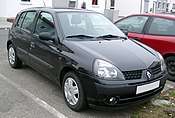
_Expression_5-door_hatchback_(23979350141).jpg)

